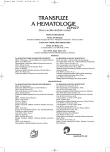Confirmatory HLA typing results as an indicator of quality of the HLA typing of the door pool: Czech national marrow doors registry (CNMDR) experience
Authors:
P. Jindra 1,2; Z. Ambrůzová 3; F. Mrázek 3; H. Pittrová 1; J. Navrátilová 1; K. Steinerová 1,2; V. Koza 1,2
Authors‘ workplace:
Český národní registr dárců dřeně, Plzeň, 2Hematologicko-onkologické oddělení, FN Plzeň, 3HLA laboratoř
Ústav imunologie, FN Olomouc
1
Published in:
Transfuze Hematol. dnes,13, 2007, No. 3, p. 142-148.
Category:
Comprehensive Reports, Original Papers, Case Reports
Overview
Objective estimation of the HLA typing quality of the donor registry could be deduced from the analysis of confirmatory typing results. We tested this approach in the Czech National Marrow Donors Registry. CT results information has been continuously collected separately for HLA-AB (serology) and DRB1 (DNA) during period of 1998-2005. Altogether 758 results were analysed for HLA-A,B and 1107 for DRB1. Serological HLA-A,B phenotypes were confirmed in 704 (92.9 %) donors with the 2972/3032 (98 %) correctly serologically assigned HLA-A,B antigens. In 26/54 (48%) of incorrectly typed, the discrepancies were caused by serologically missed antigens. In this group the less frequent or rare antigens predominates (14/27 discrepancies in 26 donors). In the misassigned and overassigned antigen group a prevalence of CREG-type errors was reported (28/33 discrepancies in 31 donors), with a majority being wrongly assigned splits (19/28 CREG errors). In totally, 16/54 (30 %) of unconfirmed results were related to A19 group mistyping. The DRB1 accuracy was excellent; only 8/1107 (0.7%) donors were unconfirmed. Discrepancy rate was insignificantly higher for donors recruited during 1993-98 than for donors recruited later (59 vs. 41 %, p=0,21). The system represents a simple tool allowing determination of the quality of HLA-A, -B serological, as well as DRB1* DNA typing of a national registry, and complements classical QC programmes. The transition to DNA-based typing of Class I at recruitment will solve the problem of errors inherent in serology.
Key words:
confirmatory typing, HLA typing, quality control, serology, stem cell registry, typing discrepancies, DNA analysis
Sources
1. Gratwohl A, Baldomero H, Fraunedorfer K, Urbano-Ispizua A and Niederwieser D, for the Joint Accrediation Committee of the ISCT and EBMT. Results of the EBMT activity survey 2005 on haematopoietic stemcell transplantation: focus on increasing use of unrelated donors. Bone Marrow Transplant 2007; 39: 71–87.
2. Oudshoorn M, Cornelissen JJ, Fibbe WE, de Gareff-Meeder ER, Lie JL Schreuder GM, et al. Problems and possible solutions in findings an unrelated bone marrow donor. Results of consecutive searches for 240 Dutch patients. Bone Marrow Transplant 1997; 20: 1011–1117.
3. Tiercy JM, Bujan-Lose M, Chapuis B, Gratwohl A, Gmur J, Seger RA, et al. Bone marrow transplantation with unrelated donors: what is the probability of identifying an HLA-A,/B/Cw/DRB1/B3/B5/DQB1-matched donor? Bone Marrow Transplant 2000; 26: 437–441.
4. Bone Marrow Donors Worldwide. Available at URL: http://www.bmdw.org.
5. Schaffer M, Ollerup O. HLA-AB typing by polymerase-chain reaction with sequnce-specific primers: more accurate, less errors, and increased resolution compared to serological typing. Tissue Antigens 2001; 58: 299–307.
6. Lorentzen DF, Iwanaga KK, Meuer KJ, Moritz TL, Watkins DI. A 25% error rate in serologic typing of HLA-B homozygotes. Tissue Antigens 1997; 50: 359–365.
7. Yu N, Ohashi M, Alosco S, Granja C, Salazar M, Hegland J, et al. Accurate typing of HLA-A antigens and analysis of serologic deficiencies. Tissue Antigens 1997; 50: 380–386.
8. Tiercy JM, Bujan-Lose M, Chapuis B, Gratwohl A, Schanz U, Seger RA, et al. Quality control of a national marrow donor registry: results of a pilot study and proposal for standardized approach. Bone Marrow Transplant 2003; 32: 623–637.
9. Noreen HJ, You N, Setterholm M, Ohashi M, Baisch J, Endres R, et al. Validation of DNA-based HLA-A and HLA-B testing of volunteers for a bone marrow registry through parallel testing with serology. Tissue Antigens 2001; 57: 221–229.
10. Mytilineos J, Lempert M, Middleton D, Wiliams F, Cullen C, Scherer S, et al. HLA class I DNA typing of 215 ‘HLA-A-B-DR zero mismatched’ kidney transplants. Tissue Antigens 1997; 50: 355–8.
11. Gourley, IS, Kearns J, McKeen M, Birkos S, Brown M, Kamoun M. HLA Class I typing of volunteers for a bone marrow registry: QC analysis by DNA-based methodology identifies serological typing discrepancies in the assignment of HLA-A and B antigens. Tissue Antigens 2001; 59: 211–215.
12. Hurley CK, Wade JA, Oudshoorn M. on behalf of QA and DRWG of the WMDA. A Special Report: Histocompatibility Testing Guidelines for Hematopoietic Stem Cell Transplantation Using Volunteer Donors. Human Immunology 1999; 60: 347–360.
13. World Marrow Donor Associations. Available at URL: http://www.worldmarrow.org/fileadmin/workinggroups_Subcommittees/QAWG/HLA_discrepant/Discrepant_Typing_2004__Minneapolis.pdf
14. Hurley CK, Raffoux C. World Marrow Donor Association. Special Report: World Marrow Donor Association: International Staadards for unrelated hematopoietic stem cell registries. Bone Marrow Transplantation 2004; 34:103–110.
Labels
Haematology Internal medicine Clinical oncologyArticle was published in
Transfusion and Haematology Today

2007 Issue 3
Most read in this issue
- G-CSF in healthy donors. Safe or harmful?
- CTD regimen (cyclophosphamide, thalidomide, dexamethasone) in the treatment of relapsed or refractory multiple myeloma
- Clinical value of 18F-FDG-positron emission tomography in follicular lymphoma
- Production and use of blood components in Czech Republic in the year 2006
